I saw a post on Facebook the other day where the person stated that the swans in their image, taken at Bear River MBR, were a “mated pair of Trumpeter Swans” lifting off from the water.
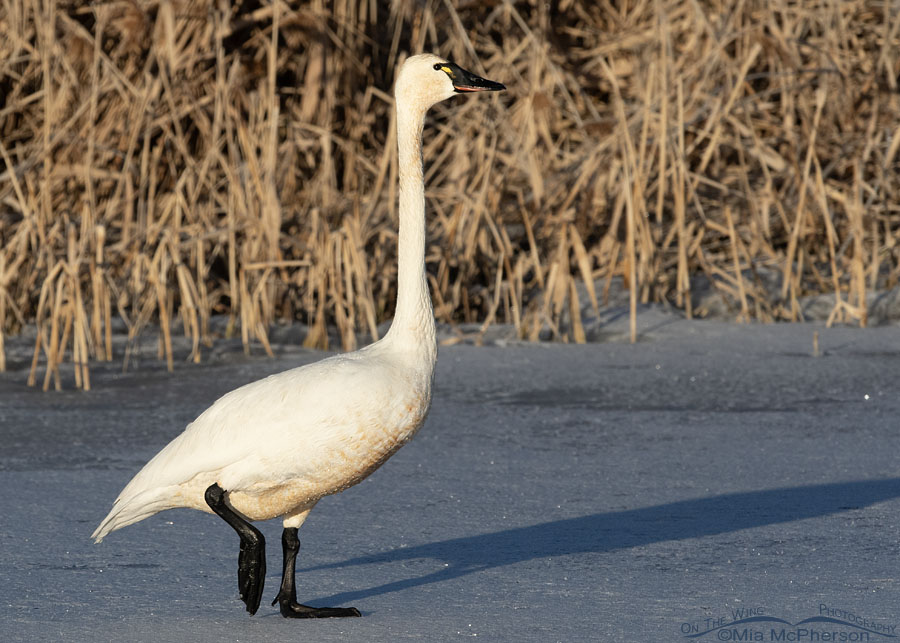 Tundra Swan standing on ice
Tundra Swan standing on ice
Since I am very much aware that the most common swans at Bear River MBR and in northern Utah are, in fact, Tundra Swans, I was curious. I clicked on the image to enlarge it, and sure enough, the swans in the photo were Tundra Swans, not Trumpeters. That misidentified swan image was shared with more than a dozen groups on Facebook.
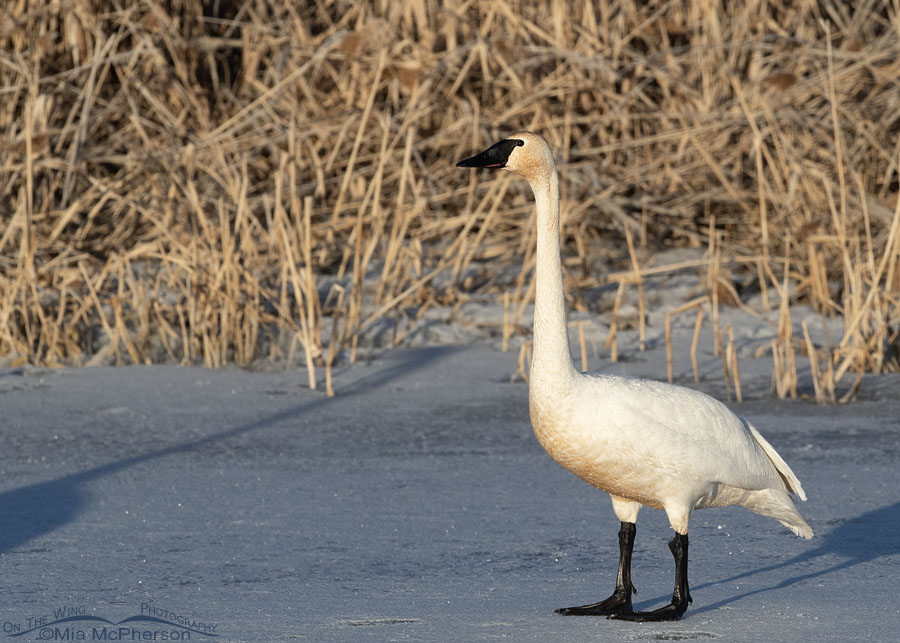 Trumpeter Swan standing on ice
Trumpeter Swan standing on ice
We do get Trumpeter Swans at the refuge, but they are few, and I’ve never found a presumed “mated” pair. I often go years without finding Trumpeters in northern Utah.
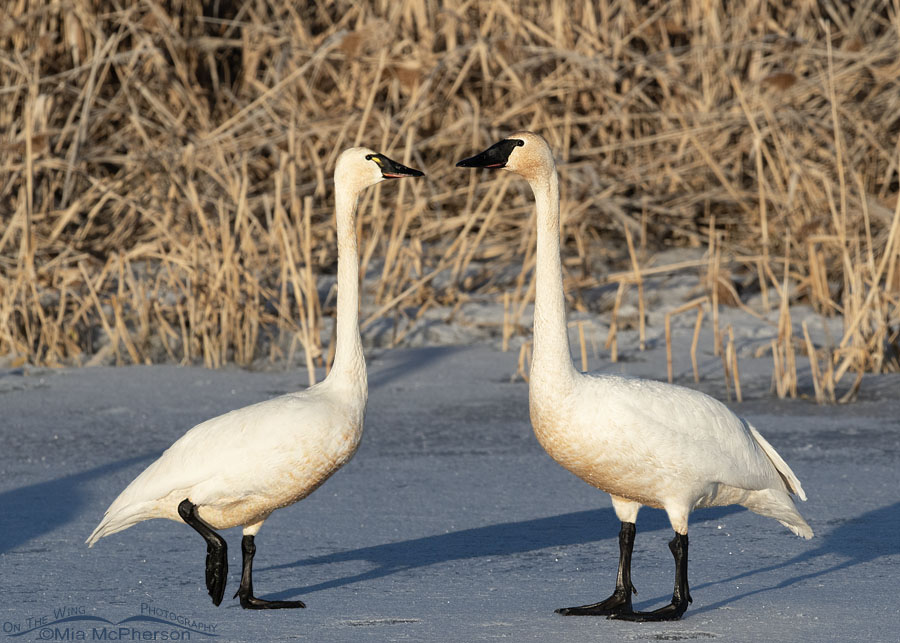 Tundra Swan and Trumpeter Swan composite image
Tundra Swan and Trumpeter Swan composite image
I created this composite image of a Tundra Swan and a Trumpeter Swan from swans that were in the same location on the same date at the refuge on February 19, 2022. I would have loved to have had the Trumpeter Swan side by side with a Tundra Swan naturally, but that didn’t happen. The Trumpeter Swan was associating with the Tundras, but it stood apart from them.
Trumpeter Swans are noticeably larger than Tundras. That is the main reason the Trumpeter caught my eye, because I know birds.
Trumpeters also have a more rounded back, but that isn’t always noticeable when there isn’t a Tundra Swan nearby to compare with. Trumpeters have a longer neck, but that wouldn’t be a feature I would use for identification if I only have a single bird in front of me.
I knew immediately that I had found a Trumpeter Swan at the refuge two years ago because I noticed its larger size compared to the Tundras. However, there are more key identification features that can be used to identify these two swan species.
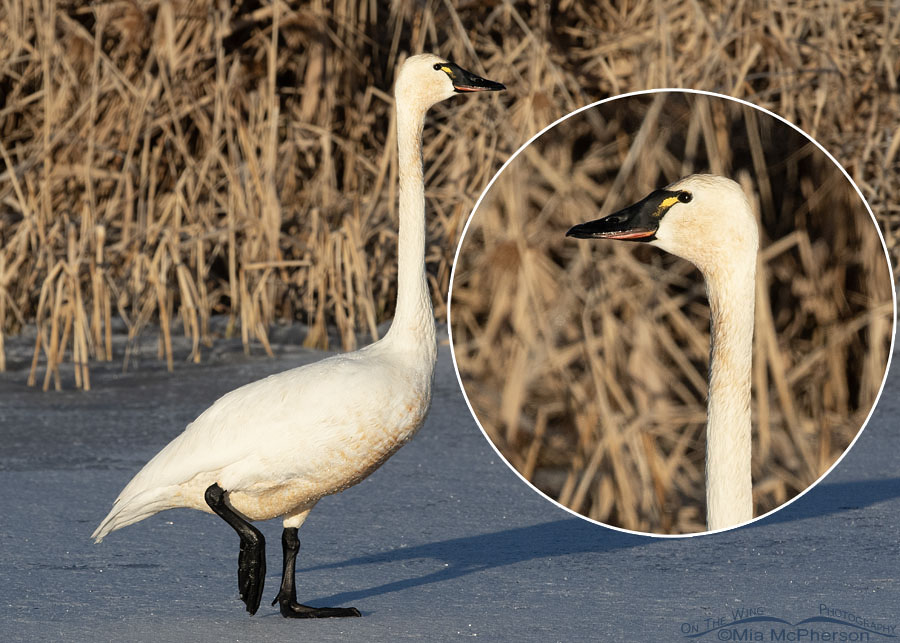 Tundra Swan standing on ice with inset
Tundra Swan standing on ice with inset
This Tundra Swan photo was taken the same morning that I found the Trumpeter Swan on the auto tour loop of the refuge. The inset shows the swan’s face flipped horizontally.
Of note, this inset clearly shows a yellow spot immediately in front of the eye that contrasts with the black bill.
Note: Not all Tundra Swans show a yellow spot on their bill. The size of the yellow spot is highly variable. It can be tiny or large. In immature Tundra Swans, the yellow spot can be white and nearly invisible from a distance. Some Tundra Swans have no spot at all on their bills.
Then there are the swans with really large yellow spots on their bills. Those can be the rare Bewick’s Tundra Swans from Eurasia, or the even more rare, Whooper or Common Swan. But I’m not writing about them today.
I found one of those spotless Tundra Swans I mentioned a few years ago and shared it with my friend, Mark Stackhouse, because I wanted to be sure of my identification. Mark is one of my go-to people when I find myself struggling with an ID. I sure appreciate Mark’s assistance on those rare occasions when I need help.
The inset above also shows a curve where the black bill meets the white feathers of the Tundra Swan’s face. Also, the top part of the bill of Tundra Swans exhibit a slightly curved appearance.
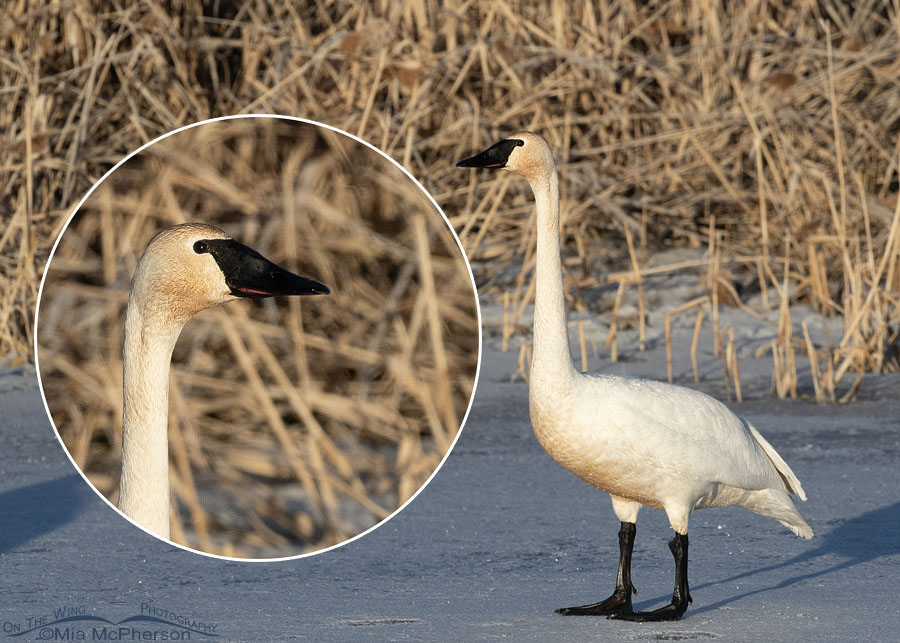 Trumpeter Swan standing on ice with inset
Trumpeter Swan standing on ice with inset
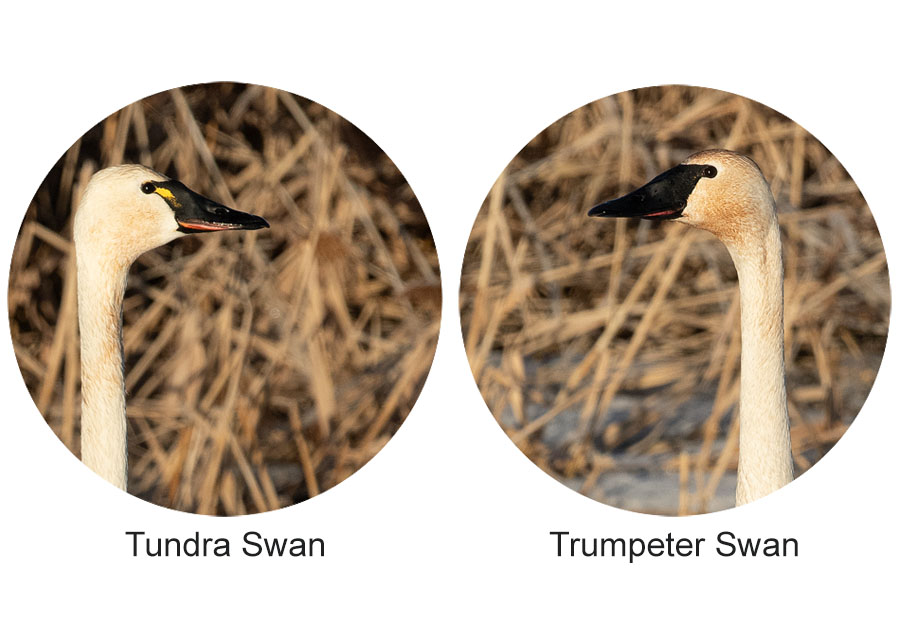 Tundra Swan and Trumpeter Swan portrait composite image
Tundra Swan and Trumpeter Swan portrait composite image
I created this composite image of just the faces of the Tundra and Trumpeter Swans for clarity. Both of these swan species are beautiful and I love having them in my viewfinder at the refuge. I wish that I could find Trumpeters more often than I do. I’m always carefully looking for them.
I hope this comparison helps anyone who might be struggling with Trumpeter Swan and Tundra Swan identification in the field or when they are looking at their own photos.
You might wonder if I contacted the person who posted the photo of the misidentified swans on Facebook to let them know about their mistaken ID.
I didn’t.
I don’t know them personally, and their photo wasn’t in a bird identification group. They weren’t requesting help with their identification.
Over the years, I have tried to help with bird identification and my brain has been picked over and over again. I don’t mind helping other people at all. In fact, I enjoy sharing my knowledge about birds.
I’ve offered ID assistance on Facebook and in bird identification groups with mixed reactions. Most of my friends are grateful when I identify misidentified birds, whether they have misidentified a bird in a post or just need help with an identification.
Other people? Not so much, even in bird identification groups.
Once a local person asked for help in one of those bird ID groups on Facebook identifying what they called a “rare” Great Egret. When I explained that Great Egrets weren’t rare in northern Utah, the guy got pretty nasty with me.
Had he not been intent on nastily attacking me, I would have told him that the white wading bird at Farmington Bay WMA that had everyone there excited was actually a rare White Ibis. As it was, the man was so awful, even after group experts supported what I had said, that the moderators turned off commenting on that post.
So, on Facebook, I am kind of hesitant to offer identification assistance if it is not explicitly asked for. I don’t need the drama that can sometimes go with it.
With that all said, I’d also like to say that I don’t and won’t call myself or consider myself an “expert.” I just happen to know a lot about birds, their behaviors, and identification.
Life is good. But yeah, sometimes I avoid giving bird identifications or my opinion on their behavior. I don’t enjoy being snapped at or treated badly.
Mia
Click here to see more of my Trumpeter Swan photos plus facts and information about this species. Click here to see more of my Tundra Swan photos plus facts and information about this species.


Nice article…very informative… the only thing I would point out is that not all swans are created equal .. lineage diet and environmental conditions may account for some observed differences among these birds…have Bewick swans been sighted in North America yet …will they influence the genetic make up of native birds? Climate change may change their migratory routes???
F.M. George, I’m fairly certain climate change will have an impact on swan migration, at least here in Utah when the Great Salt Lake declines even more than it has already.
People in Utah don’t seem willing to “Slow The Flow” with their water usage on water sucking crops like alfalfa, which by the way most of that gets shipped overseas, and their sterile, water-sucking blue grass lawns.
People dump hundreds of thousands of gallons of water on those lawns during the warmer months of the year. That water could be going to the lake.
That is adding to the cumulative damage to the lake and surrounding marshes on which the swans and millions of other birds rely.
And by the way, yes, Bewick’s Swans have been reported here in Utah and North America. I found a Bewick’s myself and although I was was only able to take documentary images of it, I was thrilled to spot it.
Extremely interesting and instructional post. The side by side comparisons of these swans is fascinating. Thanks Mia.
Wow, this is a rare and precious information for me, and it is free! Now suddenly, I am able to tell two gorgeous almost same-looking birds. So grateful.
I really appreciate this post comparing the Tundra and Trumpeter Swans!
LOL I saw the post multiple times. I did like the message intent with the post though. These are great comparisons Mia! Yes I do run into tundra without the yellow, they give me fits to ID. When I can see them side by side the beak shape is what I go for. I always think of the trumpeter as having a roman nose and the tundra a German ski jump nose. I am with you about IDing other’s mistakes. I am not expert and make mistakes too, but I am gracious and compare when someone points it out. Sometime I am wrong sometimes I was right. Usually my brain misfires and says things like crowned rather than capped. I stopped commenting on mistakes because of people being so curt. Like you I had one guy get really nasty and comments were turned off.
Thank you for sharing this information. For the past few years I have been taking photos of Mute Swans and their beak is orange. I thought they were Trumpeters or Tundra and shared them on the FB. I received messages that they were not Trumpeters but Mute Swans. I remained confused until I saw your photos. Even though you did not show a Mute Swan photo, I am assuming they were mutes. There beaks are all orange.
Thanks so much for that incredibly succinct tutorial. I have the privilege go to BRMBR whenever I want, but I lack the knowledge to know just how much diversity I probably see when I go. Now I have one more treasure to look for.
Good catch, and better judgement. I will only suggest an ID it it’s a person I communicate with often. We all get wrong, and a suggestion should be welcomed…however 😂.
Always follow your posts, very nice work.